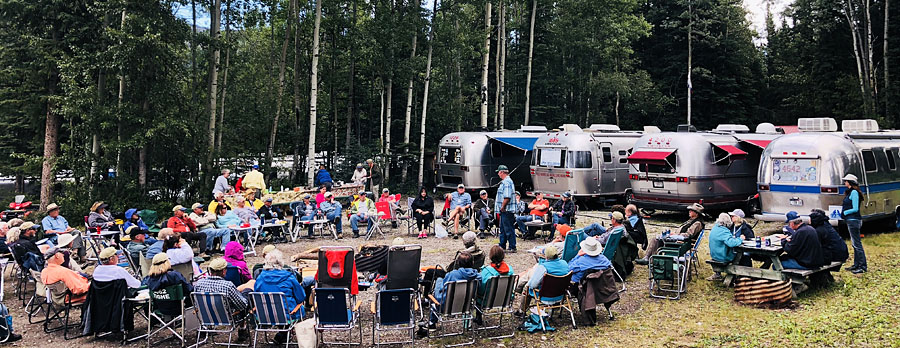
September 2018 - North to Alaska Caravan - part 1
Why would you go on a long Airstream trek to Alaska? The local license plates hail Alaska as “The Last Frontier.” Apart from Mexico with its inherent risks, Alaska offers so much to excite and thrill the adventurous outdoor traveler. This last, vast, remote, and beautiful wilderness in North America is easily within your reach! A lot of historical travel folklore would have you believe that all kinds of disasters await you! Quite the opposite.... all the main highways are paved. Road conditions are good despite permafrost and the legendary eight-month long frozen winters. The likelihood of damage from flying rocks and stones is just as likely in the lower 48. Remember, you will only probably do this once in your life so research and long range planning are essential!Your travel plan will depend on the length of time you plan to be away. For shorter trips, it’s definitely worth considering flying in and renting an RV locally. Once off the main highways, the gravel highways can take a toll on the integrity of any vehicle, so if that’s your kind of trip profile, best to use someone else’s rig rather than your own!
Another alternative is to load you rig on the ferry at Bellingham and take the Alaska Marine Highway one way or both directions for a significant fee. An added attraction is to off-load for a few days at intermediary stops and explore the otherwise inaccessible islands along the Alaskan coastline.
Planning an Alaskan trip needs at least a two-month window, much of the time spent getting there and getting back through Canada, also adding travel time from your own home base which can double the travel schedule. Both the Alaskan Highway and the Casieri Highway are good condition two lane roads, however average traffic speed can be quite slow, limited to the speed of the slowest vehicle, so progress from the Canadian border to the Alaskan border can take 7 or 8 days at minimum. You will probably want to stay at least a couple of nights at interesting Gold Rush historical spots on the way so two weeks is the norm.
The weather window is also critical, not too early to avoid the early summer bug and mosquito infestation, and not too late to avoid the onset of winter beginning in early September.
WBCCI runs excellent caravans every two years to Alaska - every two years? It’s a very demanding volunteer leadership role, so to avoid burn out and making this a full-time job, the caravans run on even years. At last check, over 100 rigs are on the waiting list for 2020, so signing up a few years early would be essential even if canceling nearer the time becomes a necessity. Our 2018 North to Alaska caravan has 35 rigs, runs for 63 days and travels 4,780 miles starting at Dawson Creek BC and ending in Prince George BC.
There are, of course, more frequent commercial caravans with SOBs but the fee is usually double the non-profit WBCCI rate and you have lost the camaraderie of the Airstream community.
Another practical alternative is to form your own friendly Airstream group bringing together say half a dozen friends or unit acquaintances to form an informal expedition north. The huge advantage is flexibility and access to the most beautiful campgrounds in state or provincial parks that are not logistically available to the large caravans. Part of the wonder and pleasure of traveling in Alaska is camping in the wilderness and enjoying some of the most stunning scenery and vistas in the world.
Venturing first time into unknown and distant territory may be intimidating at first glance, but once you are in Alaska you soon realize that life is pretty much the same as remote areas of the northern US with ubiquitous malls and essential supplies, but just much further apart!
Getting your rig ready for the trip north may depend on your itinerary and if you chose to travel along the Top of the World Highway or the Dalton Highway. These are unpaved packed dirt roads treated with calcium chloride, which protects the surface and allows occasional speeds of 40 mph, but mostly 15 to 25 mph when towing your Airstream. Light showers are helpful on these roads, as heavy rain turns the surface into mud and dry sunny days generate dust storms as you travel north.
Damage is most likely to come from rocks being thrown up by oncoming vehicles. Protection of truck and trailer may include heavy-duty mud flaps or rock tamers, temporary padding for exposed and vulnerable trailer windows and panels, headlight protection film, water drain protective covers, and radiator and oil cooler grills. Vibrations in the trailer traveling over these surfaces can cause a magnitude of issues, and our experience caused rivets to pop, shower doors to droop, sliding doors to jump out, glasses to shatter, the skylight to leak, and just about any unattached object to hit the floor. Some of our caravan experienced windscreen damage, punctured tires and tire failure, water leaks, tow hitches hitting the ground unloading from ferries, and many other issues.
Another part of preparedness is traveling through Canada with its border controls and restrictions. Our caravan crossed the border eight times, which involves many questions and checks! Food and alcohol are controlled and inspections do require removal of produce and meats that are not labeled or sealed in original packaging. Planning meals to eat prohibited supplies and making new purchases after crossing the border become second nature!
Firearms and Mace seem to be top of the Canadian customs prohibited list, the irony being that you probably need the choice of a weapon of last resort in a confrontation with bears! Much more prevalent in Canada than Alaska due to more abundant plants and food sources, the bear population has become an issue with camp sites and local housing. Local site owners indicate increasingly regular bear removal by animal control and many more cases of shooting aggressive bears to protect visitors. The outdoor rules are continuously reinforced: carry bear spray, hike in groups, make lots of noise around grizzlies, however black bears don’t seem to care. Most of all do not get between a bear and its food, between a bear and her cubs, and beware of sick or injured bears that will behave aggressively and unpredictably.
One of the enjoyable aspects of planning your trip to Alaska is deciding which exciting excursions to reserve. Caravan leaders have tons of suggestions and prior experience, and it can be hard squeezing a free day out of your itinerary. If you are traveling independently, check in with previous travelers and listen to what they enjoyed. Request Alaska tourism info to be mailed and research online. Try to avoid mass tourism excursions overloaded with cruise ship passengers, which will turn most experiences into a pedestrian outing! Be aware that weather changes constantly and can make a huge difference in your life’s dream experience. You can cancel if weather turns for the worst and most likely the operator will cancel if necessary. Last minute opportunities are also worth checking, as there is often a spare seat to fill. As most of Alaska is inaccessible, check small aircraft flights, floatplanes, local cruises, water taxis, nature and photo flights, 4x4 excursions, or take your own or rent kayaks. At coastal locations, check out glacier cruises, stunning railroad trips, fishing trips, gold panning, and historical sites and artifacts of the Gold Rush era. We parked our rig and traveled on backcountry roads to interesting end of the world destinations such as Eagle, Seldovia and Wiseman where we were welcomed by local guides and entertained by their unique lifestyle.
To be continued- part 2 next month – Where did we go and what did we love?
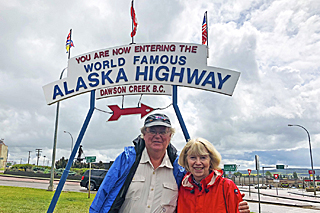 Margaret & David Broad (WBCCI #2381) from Tappahannock Virginia, traveling 8 months of the year since July 2016 in their 2015 Flying Cloud 25 RB. Their travel blog is at www.flyingcloud25.blogspot.com and David also publishes an Airstream improvement discussion at www.facebook.com/airstreamtweaks
Margaret & David Broad (WBCCI #2381) from Tappahannock Virginia, traveling 8 months of the year since July 2016 in their 2015 Flying Cloud 25 RB. Their travel blog is at www.flyingcloud25.blogspot.com and David also publishes an Airstream improvement discussion at www.facebook.com/airstreamtweaks
Where it all starts for the WBCCI Alaska caravan for 35 Airstreams: Dawson Creek, British Columbia – start of the Alaskan Highway and living-a-dream trip for two outstanding months in the wilderness.
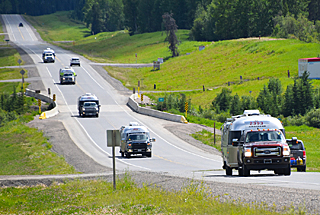 |
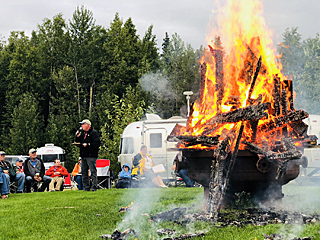 |
|
|
WBCCI Alaska 2018 caravan en route along the Alaskan Highway in small groups of 2 to 5 units staggered to avoid congestion. Built in 1942 to connect the US to Alaska as a response to the Japanese WW II threat, it took less than a year to complete the 1,387 mile highway. |
Drivers meetings are an essential part of the journey to discuss the next day’s itinerary, weather, activities, celebrate birthdays and anniversaries and sometime to warm up to a huge bonfire. |
|
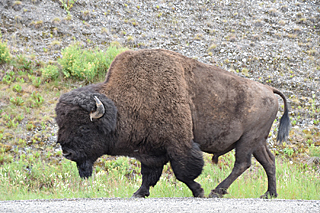 |
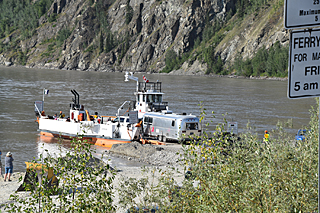 |
|
| Bison, caribou, black bears, grizzlies, dall sheep, reindeer, moose, elk, fox, wolves are all part of the wildlife encountered along the ALCAN highway. Interestingly, there seems to me more wildlife in BC and Yukon than Alaska due to more abundant wildlife food sources in the warmer southerly climate. |
Crossing the Yukon at Dawson City is always a challenge with a maximum load of two Airstreams per crossing and 3 to 4 crossings per hour. Our caravan of 35 units started the evening before and dry camped overnight along the highway to avoid delays. |
|
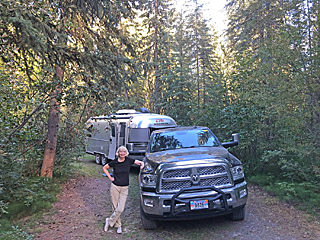 |
|
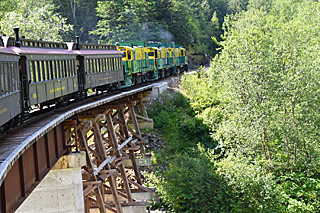 |
| Taking advantage of an early prior evening Yukon River crossing, we dry camped in a Yukon Provincial Park lost in the woods along the river bank. First come first served with room available at 9 pm - it does not get dark till gone 11 pm. Dry camping in this park for Canada $12 a night. |
At Whitehorse Yukon we boarded a bus to Carcross where we transfered to the White Pass & Yukon Route narrow gauge railroad over the Chilkoot range - famous for the Gold Rush stampede, to the US port of Skagway. The builder reputedly said: "Give me enough dynamite and I'll build you a rairoad to hell!". |
|
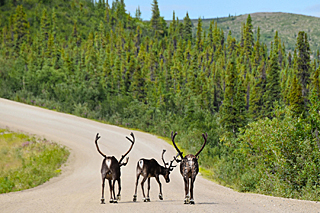 |
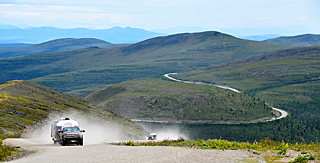 |
|
| Leaving the Alaskan Highway, we take the gravel Klondike Highway north to Dawson City where caribou abound and frequent herds bring traffic to a complete stop. |
Airstream rigs make the climb to the Top of the World Highway on the Yukon – Alaska border. Climbing to over 4,000 ft elevation on gravel highway generates a lot of dust and Airstreamers have learned to travel half a mile apart! |
|
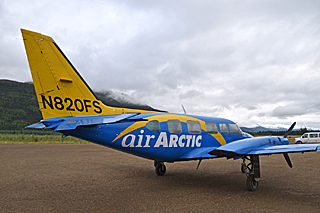 |
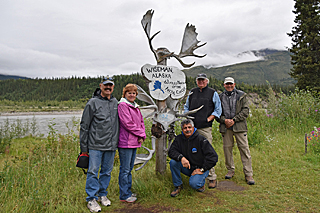 |
|
| Side travel excursions are a great enhancement to the regular caravan activities. Five of us took a small Piper aircraft to beyond the Arctic Circle (N66.33) landing at Coldfoot at the Gates to the Arctic National Park at N67.25 - W150.18. |
Crossing the Arctic Circle on a flight north to Coldfoot at the Gates to the Arctic National Park with Richard Girard (past WBCCI President), wife Jan, Joe Thomas (fellow Ham operator), myself and Ken Bauman. |
|
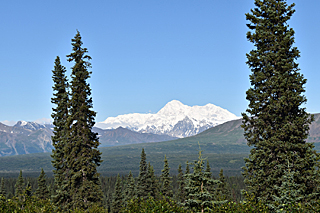 |
|
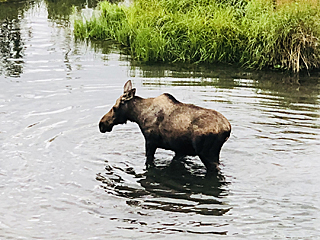 |
| Mt Denali offers us a rare glimpse on a spectacular weather break. According to most visitors, Mt Denali at 20,310 ft, is generally invisible due to low cloud and rain. |
There are plenty of unexpected encounters with wildlife so your eyes and ears need to be aware on your hikes. This female moose appeared out of the shrubbery and decided to take a morning bath. |
|
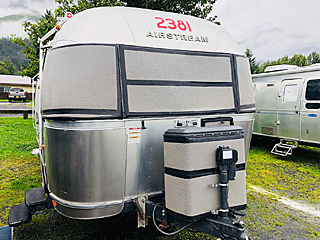 |
|
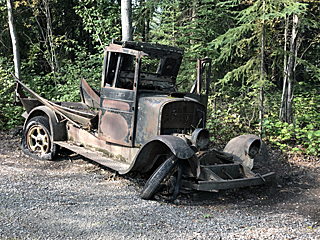 |
| Vulnerable surfaces on the Airstream are protected against road debris using yoga mat material and Gorilla tape. |
Some trucks just don't make it - abandoned truck along the Alaskan Highway near Delta Junction! |